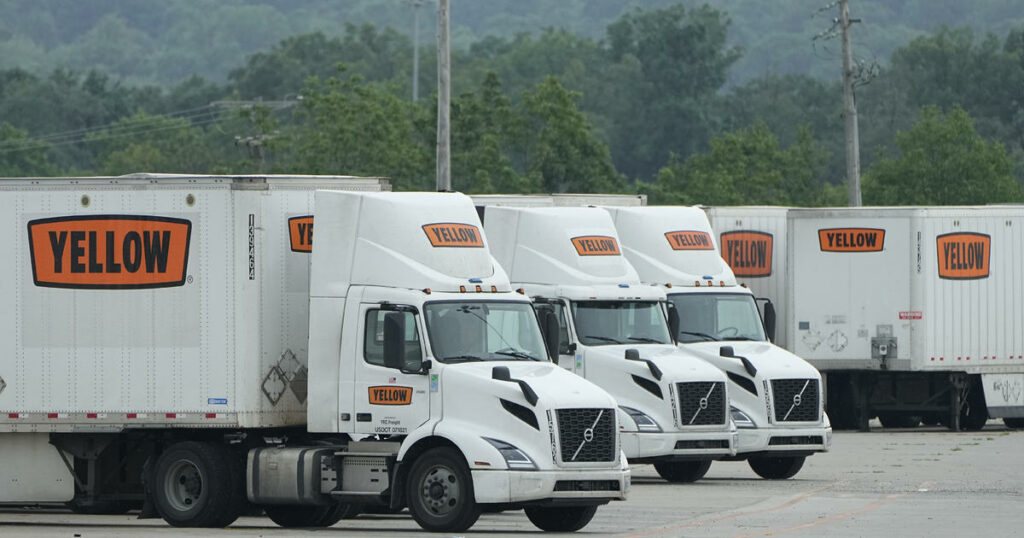Less-than-truckload hauler Yellow Corp. has sought bankruptcy protection, signaling the conclusion of the nearly century-old trucking enterprise.
In a Chapter 11 filing submitted to a Delaware court on Sunday, the company disclosed assets valued at approximately $2.15 billion and liabilities totaling $2.59 billion. The intention is to secure a debtor-in-possession (DIP) financing arrangement, which will inject liquidity to facilitate the sale of assets, meet wage obligations, and settle outstanding payments to vendors. The company reported $39 million in available cash in the filing, while also revealing a lined-up DIP financing of $142.5 million. Moreover, the company indicated that a recent evaluation of assets has indicated a valuation surpassing both secured debt and the DIP facility.
Apollo Global Management (NYSE: APO), one of the company’s existing lenders, is reportedly expected to assume the role of the primary lender for the DIP financing. This private equity firm holds a priority claim of $576 million on the company’s $1.5 billion debt. It also enjoys a superior claim position over the government in relation to a $300 million initial installment of a contentious $700 million COVID-relief loan.
Yellow CEO Darren Hawkins expressed deep regret over the development, stating, “It is with utmost disappointment that Yellow announces its closure after an almost century-long presence in the industry. In today’s times, it’s unusual for an individual to spend two or three decades, or even four, with a single company, yet Yellow had many such dedicated employees. Over generations, Yellow provided countless Americans with stable, well-compensated jobs and rewarding careers.”
The bankruptcy filing by Yellow (NASDAQ: YELL) stands as the largest in the history of the U.S. trucking sector. The most recent significant closure among less-than-truckload carriers was Consolidated Freightways, the third-largest operator in 2002 at the time of its filing. This carrier was generating around $2.3 billion in revenue and employed 20,000 individuals (including 14,500 Teamsters).
In comparison, Yellow had a workforce of 30,000 employees, of which 22,000 were Teamsters union members.
Yellow has teamed up with the American Trucking Associations to create a dedicated job database aimed specifically at former Yellow employees.
Downfall years in the making
Ultimately, Yellow’s downfall was attributed to its inability to successfully negotiate changes in its operations with the Teamsters union. These changes would have granted the company more flexible work regulations and allowed for the consolidation of its terminals and operational expenses. Yellow believed that if these alterations were implemented, its lenders would have been open to restructuring its debt, which included a substantial $1.3 billion due the following year.
The Teamsters union, however, argued that they had already made significant concessions in the past. Over the years since 2009, the union claimed to have agreed to wage adjustments, benefits modifications, and work rule changes amounting to billions of dollars.
Efforts to strike a last-minute deal with the union, negotiate with lenders, or even seek intervention from the White House ultimately proved unsuccessful. The public discourse between Yellow and the union revealed that the company could potentially run out of funds as early as July. This prompted shipping partners and third-party intermediaries to explore alternative capacity options.
The situation escalated on July 18 when a threat of a work stoppage due to overdue benefits payments led to an acceleration of customer defections.
The crisis culminated with Yellow ceasing pickups nearly two weeks prior, and subsequently laying off most nonunion employees on July 28. On July 30, the company officially closed its operations, without providing a public update. The Teamsters were the ones who disclosed that Yellow would be filing for bankruptcy.
Although the company’s employees faced sudden termination, Yellow’s downfall had been a long time in the making. Beginning in the early 2000s, Yellow pursued an expansion strategy through various acquisitions, both large and small. However, these acquisitions were largely unsuccessful in terms of integration. The company managed to avert financial disaster on multiple occasions, thanks to interventions from the union, lenders, and governmental support.
In its most recent quarterly report, Yellow reported yet another net loss and an operating ratio exceeding 100%, indicating financial difficulties. The company’s debt burden was also a significant concern, with a debt-to-adjusted earnings ratio of 4.6 times over the trailing 12 months. This level of debt was more than double what is typically considered sustainable for a company that is not experiencing growth or actively making acquisitions.
What’s the stock worth?
Ultimately, the value of the company’s equity took an unexpected turn, appearing more valuable when assessed based on its asset worth.
During May and June, shares of the company were trading around $1.50. However, as its operations neared an end, the stock price plummeted to less than 60 cents. This changed dramatically when it became evident that the company would file for bankruptcy. At this point, the valuation shifted away from considering potential future earnings and focused on the value of its physical terminals. Consequently, the shares surged to more than $4.
Boston-based hedge fund MFN Partners acquired a significant 42.5% ownership stake in the company between July 10 and the end of the month. There was speculation that this move might have been a protective measure related to MFN’s $900 million investment in another less-than-truckload (LTL) peer, XPO (NYSE: XPO). The value of XPO’s shares had doubled over the year, and the hedge fund might have seen a potential decline if Yellow were to survive.
Another factor driving interest in Yellow’s stock was the presence of the company’s 166 owned terminals, totaling 10,000 doors. These terminals were perceived to hold considerable value in a liquidation scenario. The company had recently reported an $80 million gain from the sale of a property in Southern California and a $28 million gain from a terminal sale in the previous quarter.
However, this approach carried inherent risks.
Many of the premium terminal locations had likely already been closed or sold and then leased back. This strategy had been employed by the company for years to address its ongoing financial challenges. Additionally, some terminals might be situated in smaller markets or at the end of transportation routes, where finding replacement tenants could prove difficult. Moreover, it remained uncertain how many valid claims from terminated employees, unpaid vendors, pension funds, and the union would arise. These claims would likely take precedence over the rights of equity holders.
The recent surge in the stock price could also be attributed, in part, to the influence of the “meme stock” phenomenon. Retail investors, rallying around the stock on social media platforms, contributed to a significant increase in trading volumes. While these volumes often comprised relatively small trades, they surged exponentially (from an average of 1.3 million shares per day in June to a staggering 220 million on the previous Tuesday). This trading frenzy appeared to involve a dynamic where investors were trading the stock back and forth to capitalize on gains at the expense of short sellers who had held onto their positions for too long.
By July 15, the short interest in the stock had reached a notable 19%. This level of short interest likely led some investors to believe that a short squeeze was imminent. As the stock price began to rise, short sellers rushed to cover their positions by purchasing shares, thereby fueling further price increases.





